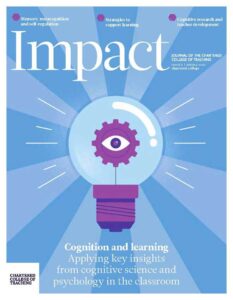A reflection on how retrieval practice has been used as a tool to improve recall and synoptic thinking in music A-level

The reformed music A-level examination requires students to think far more synoptically than the previous A-level curriculum. Students now spend two years learning a vast amount of new content, which is then tested in one two-hour exam at the end of this period. A complete understanding of the musical canon, ranging from the Renaissance period through to a 21st-century repertoire, and spanning both Western and world music traditions, is needed. Not only do students need to know about the historical, social and cultural context of each of these areas of study, but they also need to know their respective musical features and what their purposes and effects are. Students also need to be able to recognise these features aurally so that they can make informed judgements about a piece of music’s lineage. This is by no means an easy task, in particular for those students who have not had previous access to a broad range of music.
So how do we address this challenge? We must focus on long-term learning so as to ensure that our students can draw on information learnt at the beginning of the course just as confidently as they can on information learnt in their second year. We need to ensure that we embed Bjork’s desirable difficulties of spaced and interleaved retrieval practice into our curriculum, with spacing meaning the incorporation of time delays between learning and practice, and interleavingAn approach to learning where, rather than focusing on one piece of content at a time (known as blocking) then moving on to the next, students alternate between related concepts meaning the non-consecutive sequencing of content (Bjork and Bjork, 2011). We also need to increase the storage strength of the material we teach. We need to do this through the continual revisiting of previously learned material so that clear schemas are built up in our students’ memories. Students will then be able to make the necessary synoptic links between the music they hear and the musical facts they have learnt, irrespective of their previous musical knowledge.
As a result, I introduced Doug Lemov’s (2015) practice of ‘Do Now’ activities into every Year 13 A-level lesson I taught for a full academic year. A Do Now is a short warm-up activity that students can complete without instruction at the start of each lesson. It helps to settle a class whilst also developing students’ long-term memory through retrieval. I had a class of five students and saw them for three out of their eight one-hour lessons per fortnight. Spacing and interleaving were incorporated through the revisiting of previously learned material from three different time intervals, and questions from non-consecutive set works were recycled from week to week. An example is shown in Table 1.
| Interleaving/ spacing – when from? | Skill | Questions |
| Last week – Debussy | Content testing |
|
| Last month – Familia Valera Miranda | Content testing |
|
| Last year – Petals | Content testing |
|
| Ongoing | Unfamiliar listening appraisal |
|
| Ongoing | Synoptic evaluation |
|
Table 1: Example of Do Now activities used in lessons for music A-level
Students answered these questions on mini whiteboards before talking them through with a partner. Directed teacher questioning then took place. Any answers that students got wrong, they had to write down (alongside the initial question) so that they could revisit them again in their own time. Each activity was scheduled for the first 10 to 12 minutes of each lesson, although in practice they sometimes took longer.
A year on, and the A-level results now in, the positive impact is clear. Not only have some of our students surpassed our expectations in terms of attainment but the students themselves have advocated the benefits of Do Nows in helping to increase their confidence. Students are stronger and quicker at making comparative judgements about a music’s lineage and are far more self-assured at making synoptic links between unfamiliar listening extracts and the set works studied. These observational successes have been confirmed by their results: 40 per cent of the cohort exceeded their predicted grades for the analysis exam, whilst the other 60 per cent achieved their predicted grades. One student even achieved two whole grades higher than we had anticipated! Another student also mentioned that the improvement in her long-term retention of musical knowledge has helped her to have a far greater appreciation of music as a whole – a lifelong skill and benefit far beyond the A-level examination.
Whilst direct correlation in education is difficult to achieve (especially with such small-scale research), I can be relatively confident in attributing these successes to the single intervention of the Do Now. However, I must also acknowledge that other factors will have been at play – for instance, the students’ perceived difference in importance between internal and external examinations. Nevertheless, we are now rolling out Do Nows across our GCSE and Key Stage 3 curriculums (Key Stage 3 questions do not include, however, any synoptic evaluation questions). Further tweaks that we will be making to the format of these Do Nows include:
- reducing down the number of content questions to just one or two per set work so as to lessen the time that the activity takes at the beginning of each lesson
- providing the students with access to the Do Nows on the school’s VLEVirtual Learning Environment – an online system that allows teachers to share resources with students via the internet platform so that they can reuse them for revision
- asking the Year 13 A-level students to come up with questions and answers for the two last questions themselves (to be completed prior to the lesson so that the teacher can check that they are correct!)
- using a seven-minute timer on the board so as to ensure that the activity does not overrun (in practice, this means that the unfamiliar listening piece has to be played from the very start of the activity whilst the students are still answering the content questions).
Do Nows will be implemented across our music curriculum to continue to create well-rounded musicians who can approach any analysis task with confidence.
References
Bjork R and Bjork EL (2011) Making things hard on yourself, but in a good way: Creating desirable difficulties to enhance learning. In: Gernsbacher MA, Pew RW and Hough LM (eds) Psychology and the Real World: Essays Illustrating Fundamental Contributions to Society. Washington: Worth Publishers, pp. 55–64.
Lemov D (2015) Teach Like a Champion 2.0: 62 Techniques that Put Students on the Path to College. San Francisco, CA: Jossey-Bass.
This article was published in September 2018 and reflects the terminology and understanding of research and evidence in use at the time. Some terms and conclusions may no longer align with current standards. We encourage readers to approach the content with an understanding of this context.










